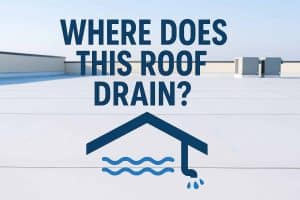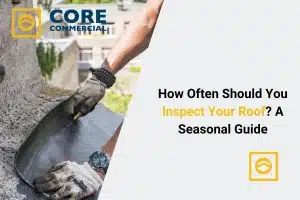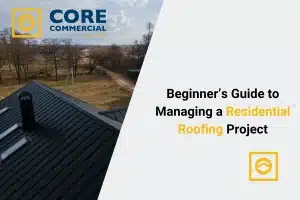Every year, business owners across Texas deal with roof damage caused by extreme heat, high winds, heavy rain, hail, and sudden temperature shifts. These aren’t rare events—they’re part of everyday life in this climate. Without proper protection, commercial roofs wear down quickly, leading to leaks, interior damage, and costly repairs.
The good news? A full roof replacement isn’t your only option. A high-quality weatherproof coating can add a durable, long-lasting shield that stands up to Texas weather—while also improving energy efficiency and reducing maintenance.
This article breaks down seven top-tier weatherproof coatings for commercial roofs, including our recommended go-to: polyurethane coatings, prized for their impact resistance, strong adhesion, and ability to withstand harsh, variable conditions. You’ll learn what each coating does best, which roof types they pair with, and how to choose the right one to safeguard your building and budget.

You’ll learn how each option stands up to local climate challenges, what problems they solve, and how they contribute to long-term savings and peace of mind.
Table of Contents
Why Weatherproofing Is Crucial in Texas
If you own or manage a commercial building in Texas, you already know what you’re up against. Triple-digit summer temperatures. Sudden downpours that dump inches of rain in minutes. Hailstones the size of golf balls. And, if you’re near the coast, hurricane-force winds. This kind of climate isn’t gentle on roofing materials. Over time, it breaks them down, causing leaks, structural damage, and expensive repairs.
Weatherproof coatings are more than just an extra layer—they’re a strategic defense system. They act as a shield against Texas’s harsh elements, keeping your roof intact and your business protected. They also help lower indoor temperatures, reduce energy bills, and stretch the life of your roof by years, if not decades.
What to Look for in a Roof Coating
Not all roof coatings are created equal. When shopping around, here are a few must-have qualities:
- Water Resistance: Texas sees heavy rains and hurricanes. Your coating needs to repel water and seal minor cracks.
- UV Reflectivity: With intense sunlight most of the year, a coating should bounce UV rays away to reduce heat absorption.
- Flexibility: As your roof expands and contracts with temperature swings, the coating should move with it without cracking.
- Durability: It must stand up to foot traffic, falling debris, and hail.
- Energy Efficiency: Look for coatings that help keep your building cool inside, lowering the burden on HVAC systems.
Acrylic Roof Coatings: UV Reflection and Cost-Effective Protection
Acrylic coatings are one of the most popular solutions for commercial roofs in Texas, and for good reason. These water-based coatings are known for their excellent UV resistance. That means less heat is absorbed by your building, reducing air conditioning costs in those scorching Texas summers.
Benefits:
- Reflects sunlight, keeping interiors cooler
- Cost-effective and easy to apply
- Ideal for low-slope roofs
- Adds a seamless, protective layer
Drawbacks:
- Not ideal for ponding water
- Can wear faster in areas with high rainfall
Best for: Buildings in sunny, dry parts of Texas, like El Paso or Midland.
Silicone Roof Coatings: The Waterproof Workhorse
When it comes to handling Texas-sized rainstorms, silicone coatings are your best friend. They form a rubber-like, fully waterproof membrane that stands up even to standing water—something acrylics struggle with.
Benefits:
- Outstanding water resistance
- Long lifespan (up to 20 years)
- Handles ponding water and humidity
- Resists mold, mildew, and staining
Drawbacks:
- Slightly more expensive than acrylic
- Can be slippery when wet
Best for: Coastal cities like Houston or Galveston, where heavy rainfall and humidity are common.
Polyurethane Roof Coatings: Tough Against Impact and Abrasion
If your building sees a lot of foot traffic or is located in a hail-prone zone, a polyurethane roof coating might be the right choice. These coatings are known for their hard, impact-resistant surface.
Benefits:
- Superior protection against hail and debris
- Resistant to wear from foot traffic
- Good waterproofing capability
Drawbacks:
- Requires professional installation
- May yellow with UV exposure (though topcoats can fix this)
Best for: Warehouses, distribution centers, and buildings in hail-heavy areas like the Dallas-Fort Worth region.
Asphalt Emulsion Coatings: Affordable and Reinforced
Seeking a budget-friendly option that provides reliable protection? Asphalt emulsion coatings are water-based and made with asphalt particles, making them thicker and more resistant to damage than you might expect.
Benefits:
- Cost-effective
- Adds strong reinforcement to aging roofs
- Good UV protection when used with reflective topcoats
Drawbacks:
- Heavier application required
- Less reflective unless layered with reflective material
Best for: Older buildings needing reinforcement without breaking the bank.
Rubberized Roof Coatings: Flexible and Durable
Rubber-based coatings offer excellent elasticity, which is key when temperatures swing from 40°F in the morning to 100°F by midday—a common occurrence in Texas springtime.
Benefits:
- Highly flexible and crack-resistant
- Waterproof and weather-resistant
- Easy to maintain and recoat
Drawbacks:
- Not always as UV-reflective as other options
- Can be more expensive per gallon
Best suited for: Buildings with aging membranes or those experiencing frequent temperature fluctuations.
Cool Roof Coatings: Lower Bills, Higher Performance
Cool roof coatings are engineered specifically to reflect more sunlight and absorb less heat. For Texas buildings struggling with heat management and high utility bills, these coatings offer a double win: lower interior temperatures and lower AC usage.
Benefits:
- Lower cooling costs up to 30%
- Improves indoor comfort
- Reduces environmental impact
Drawbacks:
- Best when paired with proper insulation
- May need occasional touch-ups
Best for: Schools, hospitals, and office buildings where energy costs are a major concern.
Reflective Roof Coatings: Texas Heat Doesn’t Stand a Chance
Texas sun is relentless. Reflective coatings like white elastomeric or aluminum-based paints are designed to bounce that heat right back up into the sky, keeping your roof—and your business—cooler and safer.
Benefits:
- Reflects UV and infrared rays
- Helps maintain a consistent indoor temperature
- Prevents thermal cracking and expansion
Drawbacks:
- Performance can degrade over time without maintenance
Best for: Urban buildings with flat roofs exposed to all-day sun.
Choosing the Right Coating for Your Roof
There’s no one-size-fits-all solution. The right coating depends on your building’s age, roof type, exposure to elements, and budget. Here’s a quick cheat sheet:
| Coating Type | Best For | Key Strength |
|---|---|---|
| Acrylic | Sunny areas, budget projects | UV reflection |
| Silicone | Wet climates, ponding water | Waterproofing |
| Polyurethane | Hail zones, foot traffic | Impact resistance |
| Asphalt Emulsion | Older roofs, tight budgets | Strength + affordability |
| Rubberized | Extreme temp swings | Flexibility |
| Cool Roof | Energy efficiency | Heat reduction |
| Reflective | Sun-heavy exposure | UV & heat reflection |
How Coatings Extend Roof Life and Cut Costs
Applying a roof coating isn’t just about today—it’s about protecting your investment for the long haul. Coatings can extend the life of a commercial roof by 10–20 years. That’s a decade or more without expensive tear-offs, business disruption, or replacement costs.
They also help you:
- Reduce repair needs: Minor cracks and leaks get sealed before they grow.
- Cut energy costs: Lower interior heat means smaller HVAC bills.
- Stay compliant: Many coatings help meet Texas building code energy requirements.
- Boost property value: A well-maintained roof increases resale or lease potential.

Final Thoughts: Invest Now, Save Later
Weatherproofing your roof isn’t just about avoiding leaks; it’s about future-proofing your building. The right coating can reduce your long-term maintenance, slash energy costs, and help your business weather whatever Texas throws your way.
From dry heat and sudden hail to torrential rain, there’s a proven coating that can match your conditions and protect your roof. Choose wisely, apply properly, and inspect annually and your roof will serve you well for years to come.
FAQs
What’s the best roof coating for Texas heat?
In Texas, where intense heat is common, silicone and acrylic roof coatings are highly effective. Silicone coatings offer excellent UV resistance and waterproofing, making them ideal for hot climates. Acrylic coatings are also reflective, helping to reduce cooling costs by reflecting sunlight away from the building.
How long do the roof coatings last in Texas?
The lifespan of commercial roof coatings in Texas varies by type and environmental conditions. Generally, silicone coatings can last up to 20 years, while acrylic coatings may last around 10-15 years. Regular maintenance can extend their effectiveness.
Do roof coatings stop leaks during Texas storms?
Yes, roof coatings can provide a seamless, waterproof barrier that helps prevent leaks during heavy Texas storms. Silicone coatings, in particular, are known for their excellent waterproofing properties, making them suitable for areas prone to heavy rainfall.
Are roof coatings good for flat commercial roofs in Texas?
Absolutely. Roof coatings are ideal for flat commercial roofs, as they can address issues like ponding water and UV damage. Silicone and acrylic coatings are commonly used to protect and extend the life of flat roofs in Texas.
How much does roof coating cost in Texas?
The cost of commercial roof coating in Texas depends on factors like roof size, coating type, and labor. On average, prices range from $1.50 to $4.50 per square foot. It’s advisable to obtain quotes from local contractors for accurate pricing.
Do roof coatings save energy in Texas?
Yes, reflective roof coatings can significantly reduce cooling costs by reflecting sunlight and reducing heat absorption. This is particularly beneficial in Texas, where high temperatures can lead to increased energy usage for cooling.
Can I put roof coating on by myself?
While a DIY application is possible, it’s recommended to hire professionals for commercial roof coatings. Proper surface preparation and application are crucial for the coating’s effectiveness and longevity, and professionals have the necessary equipment and expertise.
What maintenance do I need after putting on a roof coating?
Post-application, regular inspections (at least twice a year) are essential to check for damage or wear. Cleaning the roof to remove debris and addressing any issues promptly can help maintain the coating’s protective qualities.
Are there eco-friendly roof coatings for buildings in Texas?
Yes, many roof coatings are environmentally friendly. Acrylic coatings are water-based and low in VOCs, making them a sustainable choice. Additionally, reflective coatings can reduce energy consumption, contributing to environmental conservation.
How do I pick the best roof coating for my Texas commercial building?
Selecting the right roof coating involves considering factors like roof type, climate, and specific building needs. Consulting with a professional roofing contractor can help determine the most suitable coating to ensure optimal performance and longevity.





